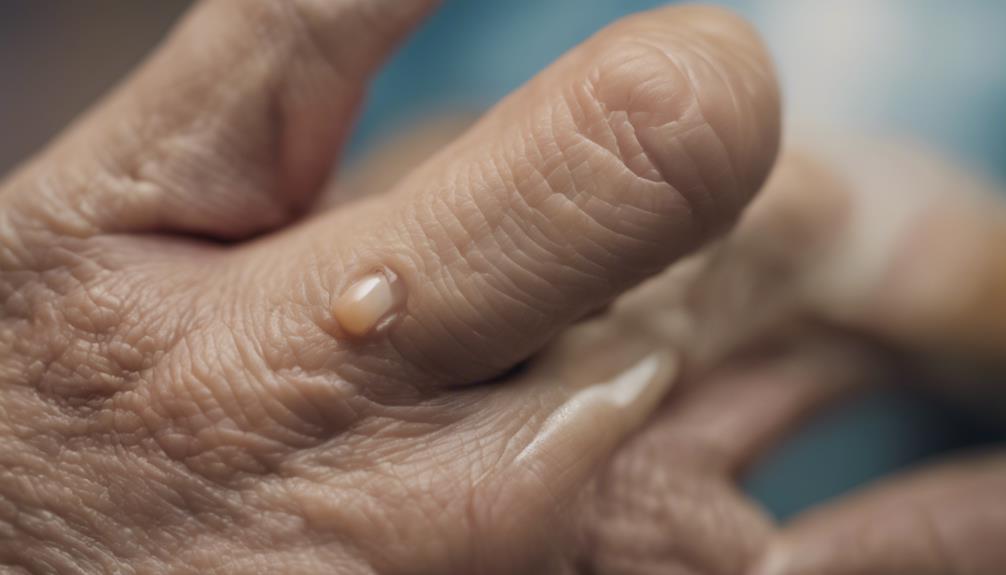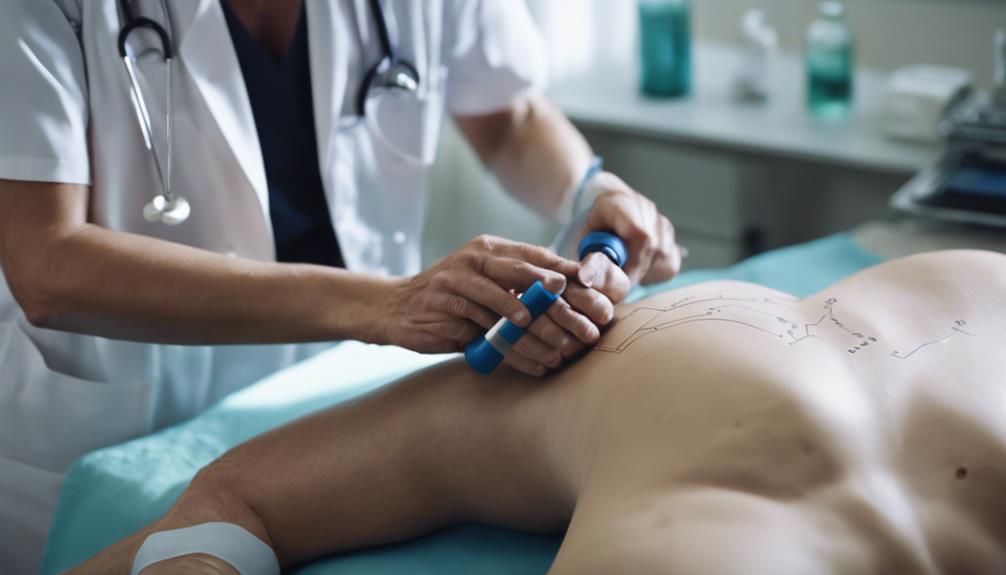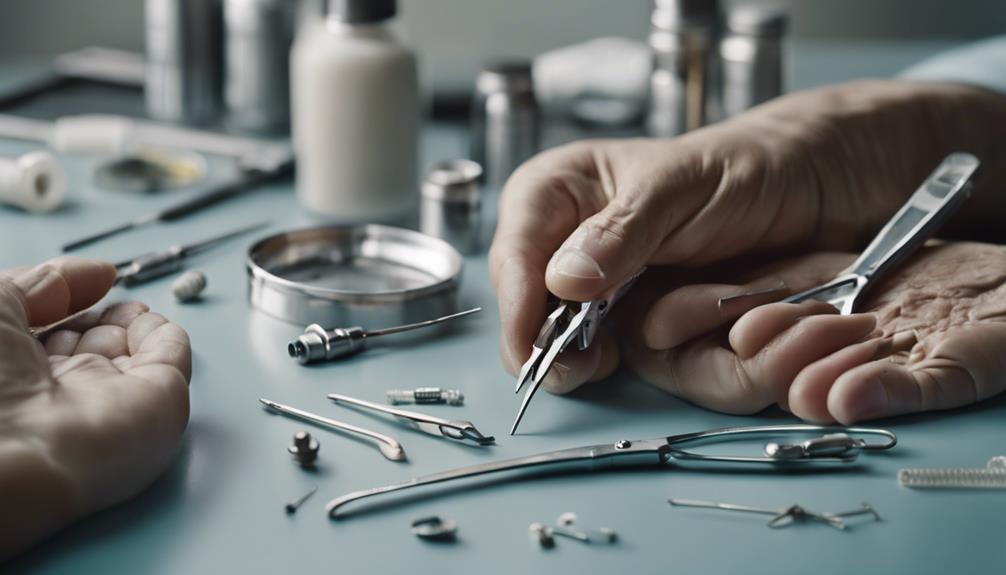What Is Nail Patella?

Nail Patella, or Nail Patella Syndrome (NPS), is a genetic disorder caused by mutations in the LMX1B gene impacting nail, knee, and elbow development. Common features include nail abnormalities, skeletal issues like hypoplastic patellae, renal complications such as proteinuria, and musculoskeletal symptoms affecting physical function. Management involves a multidisciplinary approach with orthopedic care, genetic counseling, physical therapy, and regular renal monitoring. Surgical interventions can stabilize patellar dislocations, while proactive care can enhance quality of life. Understanding the genetic and clinical aspects of NPS is crucial for optimal management and improved outcomes.
Key Takeaways
- Nail Patella Syndrome is a genetic disorder affecting nails, knees, and elbows.
- Mutations in the LMX1B gene cause Nail Patella Syndrome.
- Clinical features include nail abnormalities and skeletal issues like hypoplastic patellae.
- Renal complications like proteinuria and nephrotic syndrome can occur.
- Management involves multidisciplinary care, orthopedic interventions, and regular renal monitoring.
Genetic Basis of Nail Patella

The genetic basis of Nail Patella syndrome, also known as NPS, lies in mutations of the LMX1B gene. This gene provides instructions for making a protein that plays a crucial role in the development of nails, knees, elbows, and other body tissues. Mutations in the LMX1B gene can disrupt the normal formation of these structures, leading to the characteristic features of Nail Patella syndrome.
Understanding the genetic underpinnings of NPS opens up avenues for innovative research and potential treatments. Advances in genetic testing technologies have enabled more precise identification of mutations in the LMX1B gene, allowing for personalized approaches to managing the syndrome. Furthermore, ongoing research into the molecular mechanisms affected by these mutations holds promise for the development of targeted therapies that address the root cause of NPS at a genetic level.
Clinical Features and Symptoms
Manifestations of Nail Patella syndrome include distinctive physical features and a range of symptoms that can affect multiple systems in the body. One of the hallmark signs of Nail Patella syndrome is the presence of abnormalities in the nails, such as absent or underdeveloped nails, ridges, or pitting. Additionally, individuals with this syndrome often exhibit skeletal abnormalities like hypoplastic patellae, elbow deformities, and iliac horns. Renal involvement is common, with individuals potentially experiencing proteinuria and nephrotic syndrome. Ocular abnormalities, including glaucoma, cataracts, and pigmentary retinopathy, can also occur in some cases. Musculoskeletal symptoms such as joint laxity and muscle weakness may impact mobility and physical functioning. Furthermore, individuals with Nail Patella syndrome may present with hypertension and an increased risk of developing kidney disease. Understanding the diverse clinical features and symptoms associated with Nail Patella syndrome is crucial for timely diagnosis and management of this condition.
Diagnostic Tests for NPS

Exploring the Diagnostic Evaluation for Nail Patella Syndrome reveals essential tests that aid in accurate diagnosis and treatment planning. A key diagnostic test for NPS is genetic testing to identify mutations in the LMX1B gene, which plays a crucial role in the development of this syndrome. Additionally, imaging studies such as X-rays can help detect skeletal abnormalities commonly seen in NPS, including patellar hypoplasia and iliac horns. Urinalysis may also be recommended to assess for proteinuria, a common renal manifestation of NPS. Furthermore, a thorough physical examination focusing on musculoskeletal and renal abnormalities is essential for a comprehensive diagnostic assessment.
Innovative approaches such as next-generation sequencing techniques have enhanced the efficiency and accuracy of genetic testing for NPS, enabling quicker identification of pathogenic variants. Advancements in imaging technology have improved the visualization of skeletal anomalies associated with NPS, aiding in prompt diagnosis and treatment initiation. By utilizing a combination of these diagnostic tests, healthcare providers can effectively diagnose Nail Patella Syndrome and tailor treatment strategies to address the specific needs of each patient.
Management Approaches for NPS
Utilizing a multidisciplinary approach, effective management strategies for Nail Patella Syndrome involve addressing both musculoskeletal abnormalities and renal complications to optimize patient outcomes. In the management of Nail Patella Syndrome (NPS), a comprehensive plan that combines orthopedic care, nephrology, and genetic counseling is essential. For musculoskeletal abnormalities such as patellar instability, joint contractures, and iliac horns, physical therapy, orthotics, and surgical interventions may be employed to improve mobility and reduce pain. Regular monitoring of renal function through blood tests and urinalysis is crucial to detect and manage any potential kidney involvement promptly. Additionally, genetic counseling can provide valuable information regarding the hereditary nature of NPS and offer guidance on family planning.
Innovative approaches such as regenerative medicine techniques, personalized treatment plans based on genetic profiles, and telemedicine for remote monitoring and consultations are emerging trends in the management of NPS. Collaborative efforts between specialists, patients, and their families are vital in ensuring a holistic and proactive approach to managing Nail Patella Syndrome.
Orthopedic Interventions for NPS

Orthopedic interventions play a crucial role in managing musculoskeletal abnormalities associated with Nail Patella Syndrome (NPS). Patients with NPS often present with skeletal issues such as patellar instability, limited range of motion, and hip, elbow, and knee joint problems. To address these challenges, innovative orthopedic interventions have been developed to improve the quality of life for individuals with NPS.
One key orthopedic intervention for NPS is surgical correction of patellar dislocation or instability. This procedure aims to stabilize the kneecap, enhance joint function, and reduce pain. Additionally, orthopedic specialists may recommend physical therapy programs tailored to strengthen muscles, improve flexibility, and enhance overall joint stability.
In cases where joint deformities significantly impact mobility and daily activities, orthopedic surgeons may consider joint replacement surgeries. These advanced interventions, coupled with ongoing monitoring and personalized care, can help individuals with NPS maintain optimal musculoskeletal health and function. By leveraging cutting-edge orthopedic strategies, healthcare providers strive to enhance outcomes and empower patients with NPS to lead fulfilling and active lives.
Renal Complications in NPS
Renal complications present a significant concern in individuals diagnosed with Nail Patella Syndrome (NPS). Approximately 30-50% of NPS patients experience kidney abnormalities, ranging from mild proteinuria to end-stage renal disease. The most common renal manifestation is nephrotic syndrome, characterized by protein loss in urine, edema, and high cholesterol. Glomerular filtration rate decline, hypertension, and chronic kidney disease are also prevalent among NPS patients.
The pathogenesis of renal complications in NPS is linked to mutations in the LMX1B gene, affecting kidney development and function. Innovations in genetic testing have enabled early detection of these mutations, allowing for proactive monitoring and management of renal issues in NPS individuals. Treatment strategies often involve controlling blood pressure, reducing proteinuria, and addressing other renal complications promptly to slow disease progression.
Collaboration between nephrologists, geneticists, and other healthcare professionals is crucial in providing comprehensive care for NPS patients with renal involvement. Ongoing research focusing on novel therapies and personalized medicine holds promise for improving outcomes and quality of life for individuals facing renal complications associated with NPS.
Prognosis and Outlook for NPS

When considering Nail Patella Syndrome (NPS), it is crucial to acknowledge the long-term health implications it may pose. Understanding the available treatment options is vital in managing the condition effectively. Additionally, exploring the impact of NPS on the quality of life can provide valuable insights for patients and healthcare professionals alike.
Long-Term Health Implications
Long-term health implications for individuals with Nail Patella Syndrome (NPS) encompass a range of potential outcomes that may impact their overall well-being and quality of life. While the severity of symptoms can vary, some individuals with NPS may experience chronic kidney disease, hypertension, and joint issues that can lead to mobility challenges. Additionally, there is an increased risk of developing glaucoma, a condition that affects vision. The long-term management of NPS often requires a multidisciplinary approach involving healthcare professionals such as nephrologists, ophthalmologists, and orthopedic specialists. Regular monitoring and early intervention are crucial in addressing potential complications and optimizing outcomes for individuals with NPS. By staying informed about the latest research and treatment options, individuals with NPS can proactively manage their health and well-being.
Treatment Options Available
In addressing Nail Patella Syndrome (NPS), the available treatment options play a crucial role in determining the prognosis and outlook for individuals affected by this condition. While NPS is a lifelong condition with no cure, innovative treatments aim to manage symptoms effectively and improve quality of life. Some of the key treatment options include:
- Physical therapy and exercise programs to enhance mobility and strength.
- Medications to alleviate pain and reduce inflammation.
- Surgical interventions such as orthopedic procedures to address skeletal abnormalities.
Quality of Life
Addressing the management of Nail Patella Syndrome (NPS), understanding the quality of life, prognosis, and outlook for individuals affected by this condition becomes pivotal in providing comprehensive care. While NPS presents challenges such as musculoskeletal abnormalities and kidney issues, advancements in medical knowledge and technology offer hope for improved outcomes. With early detection and a multidisciplinary approach to treatment, individuals with NPS can experience enhanced quality of life and better long-term prognosis. Supportive therapies, including physical therapy and assistive devices, can help manage symptoms and improve mobility. Regular monitoring by healthcare professionals is essential to address any potential complications promptly. By focusing on holistic care and personalized interventions, individuals with NPS can lead fulfilling lives and navigate their condition with resilience and optimism.
Frequently Asked Questions
Can Nail Patella Syndrome Be Prevented or Avoided?
Prevention of nail patella syndrome is not currently possible due to its genetic nature. However, early detection through genetic counseling and regular medical check-ups can help manage symptoms effectively, improving quality of life.
Are There Any Alternative Treatments or Therapies That Can Help Manage Symptoms of Nail Patella Syndrome?
There are alternative treatments and therapies that may help manage symptoms of nail patella syndrome. These can include physical therapy, assistive devices, pain management techniques, and lifestyle modifications. Consult with healthcare professionals for personalized recommendations.
How Does Nail Patella Syndrome Impact a Person's Daily Life and Overall Quality of Life?
Nail Patella Syndrome can significantly impact daily life, affecting mobility, flexibility, and fine motor skills. This condition may lead to challenges in performing routine tasks, participating in physical activities, and maintaining overall quality of life.
Are There Any Support Groups or Resources Available for Individuals and Families Affected by Nail Patella Syndrome?
Support groups and resources are crucial for individuals and families affected by nail patella syndrome. These platforms provide valuable information, emotional support, and a sense of community. Accessing these resources can enhance understanding and coping strategies for those impacted.
Is Nail Patella Syndrome More Common in Certain Populations or Regions of the World?
Nail Patella syndrome prevalence varies across populations and regions. Genetic factors are implicated in its manifestation. Research focusing on genetic diversity within populations and environmental interactions may shed light on the syndrome's distribution patterns.




